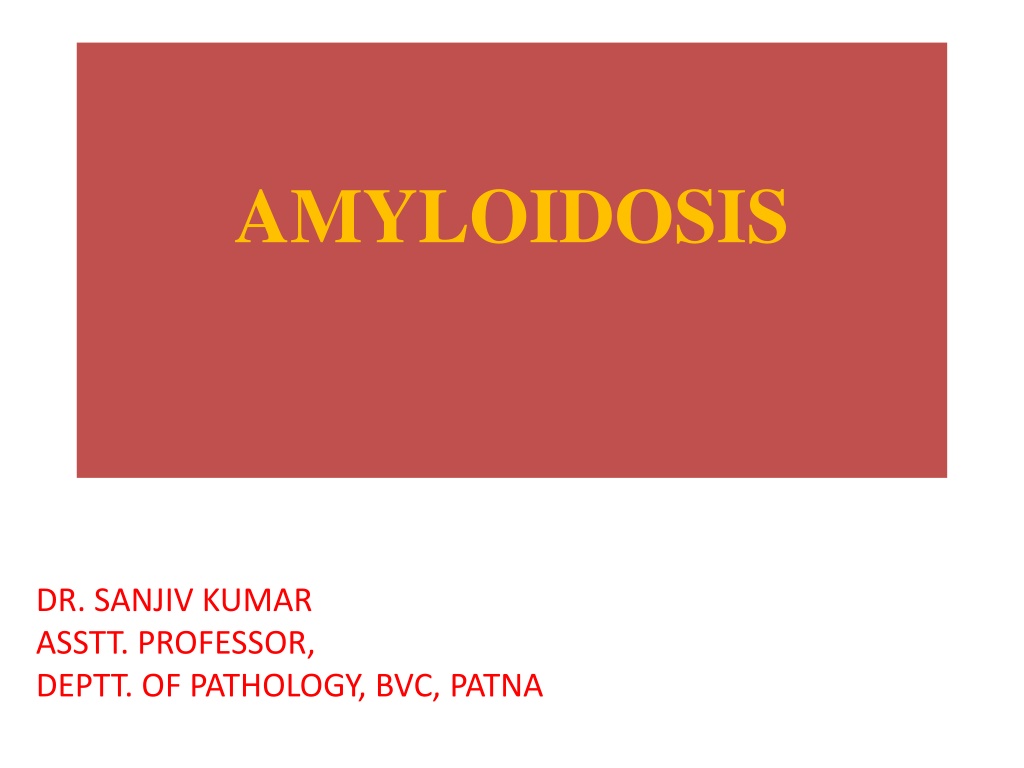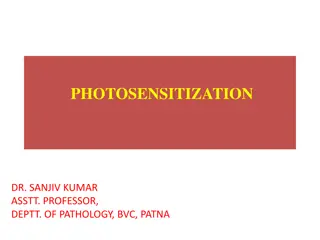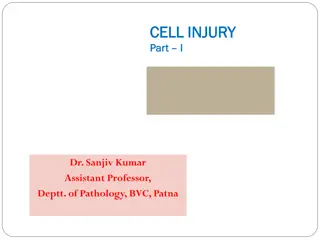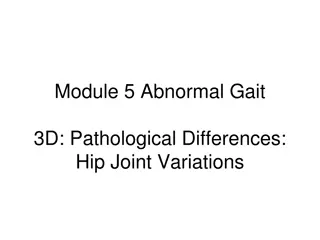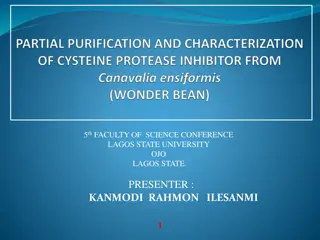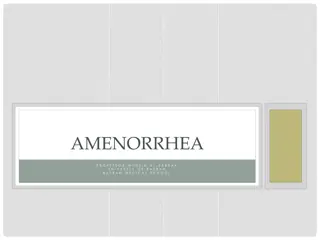Understanding Amyloidosis: Causes, Types, and Pathological Characteristics
Amyloidosis is a disorder characterized by the deposition of abnormal amyloid fibrils in tissues, impacting various organs. This condition is associated with different types of amyloid, such as AA and AL amyloid. The deposition of amyloid can lead to tissue damage and organ dysfunction. Primary and secondary amyloidosis are common forms of the disease, with distinct underlying causes. Understanding the histological characteristics, sources, and pathogenesis of amyloidosis is crucial for diagnosis and management.
Download Presentation

Please find below an Image/Link to download the presentation.
The content on the website is provided AS IS for your information and personal use only. It may not be sold, licensed, or shared on other websites without obtaining consent from the author. Download presentation by click this link. If you encounter any issues during the download, it is possible that the publisher has removed the file from their server.
E N D
Presentation Transcript
AMYLOIDOSIS DR. SANJIV KUMAR ASSTT. PROFESSOR, DEPTT. OF PATHOLOGY, BVC, PATNA
What is amyloid Amyloid (G. Amylon - STARCH) means starch-like. Amyloid is a pathologic glycoprotein deposited in the extracellular spaces and forms fibrils on polymerization.
HISTOLOGICAL CHARACTERISTICS OF AMYLOID Amyloid is specially stained with Congo Red. Under polarized light, green birefringence is noticed because of alignment of fibrils. - pleated sheet configuration is seen in X-ray diffraction. The P-component which is a glycosa-amino-glycan (GAG) facilitates polymerization of amyloid. The GAG makes the amyloid to stain with iodine. The amyloid is resistant to enzymatic digestion and progressively accumulate in tissues until the underlying disease process persists.
Types/Sources of amyloid Amyloid associated (AA): It occurs in chronic diseases and septic conditions. Precursor is serum amyloid associated protein (SAA). Amyloid light-chain (AL): It is produced in plasmacytoma and the precursor is immunoglobulin light-chain.
AMYLOIDOSIS Definition It is an immunological disorder in which homogeneous, translucent amyloid substance is deposited between capillary endothelium and adjacent cells. Pathogenesis The main event occurring in amyloidosis is the deposition of amyloid fibrils due to abnormality of protein processing. The sources of amyloid may be acute phase proteins, immunoglobulins and endocrine secretes.
The amyloid forms a -pleated sheet despite their chemical heterogeneity. This makes the fibril resistant to digestion by macrophages and phagocytic cells and hence accumulates in tissues. The amyloid, deposited around the blood vessels is more dangerous. Pressure atrophy of the adjacent cells and ischaemic anoxia results in degeneration and necrosis. Due to interference with gaseous exchange, supply of nutritents and removal of waste products and stenotic vessels, degeneration and necrosis of cells will occur amyloid precursor protein.
Types of amyloidosis Primary amyloidosis Secondary amyloidosis
Primary amyloidosis It results from antigen-antibody reaction and deposition of its precipitates. The condition is not associated with any diseases e.g. repeated exposure to antigens as in antisera and antitoxin production in horses and B cell dyscrasia (plasmacytoma) in humans in which immunoglobin light chain deposition occurs. The soluble immunoglobulin becomes insoluble with defective degradation.
Secondary amyloidosis The condition may be associated with chronic diseases like tuberculosis, septic conditions and neoplasia. This occurs in two phases. In the initial preamyloid phase, there is accumulation of reticular cells and macrophages in the spleen and other lymphoid tissue with consequent rise in plasma SAAs and globulins. During the second phase, known as amyloid phase, PAS staining cells, amyloid deposition and fall in the SAAs level are found.
Grossly, the amyloid deposition may be diffuse or focal. The amyloid is deposited around the central artery of splenic follicles and it forms sheet like deposits which is referred as bacon spleen and it may protrude resembling like a grain of sago known as sago spleen. The organ is waxy in consistency and the cut surface is grayish. Splenic corpuscles become large, gray and translucent. Liver is enlarged with rounded edges, doughy in consistency, pits on pressure and ruptures easily because of its friable nature. In renal amyloidosis, the organ is swollen, mottled, pale and yellow to orange in colour
Effects of amyloidosis Hypovolumic or haemorrhagic shock may occur following hepatic rupture. Hepatocellular atrophy occurs from pressure and nutritional deficiency. In renal amyloidosis, interfere with glomerular filtration. The enlargement and ischaemic anoxia leads to tubular epithelial degeneration and necrosis, marked proteinuria, nephrotic syndrome, uremia and death In pancreatic amyloidosis, leads to islet cell destruction and development of Diabetes mellitus. Blindness may be encountered in horses in with conjuctival amyloid deposition.
